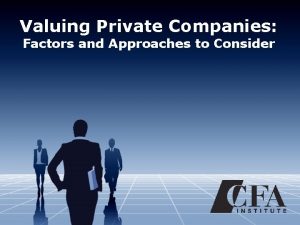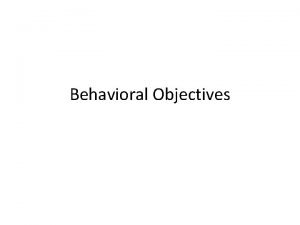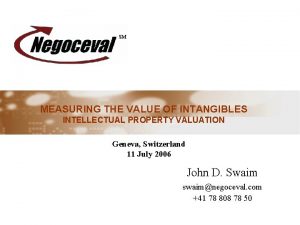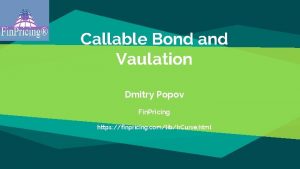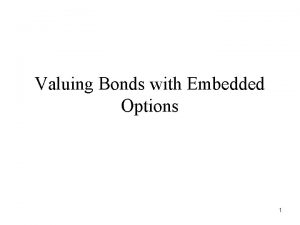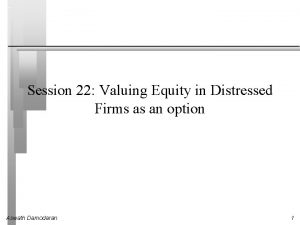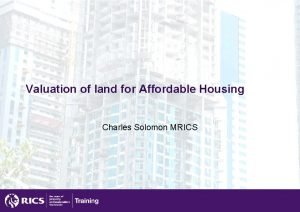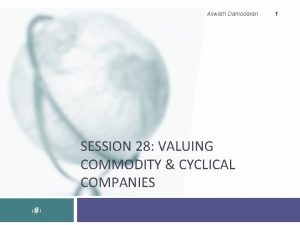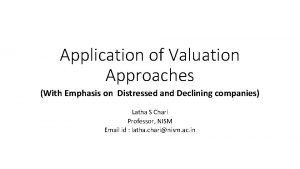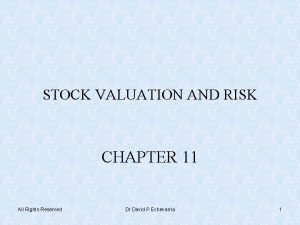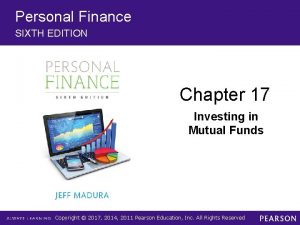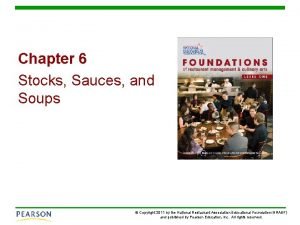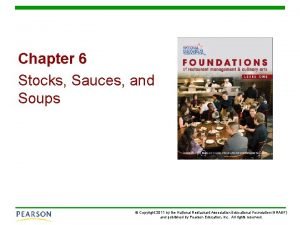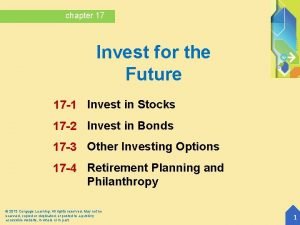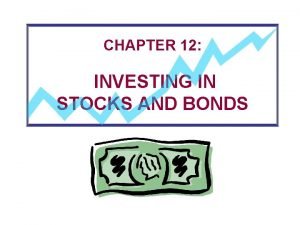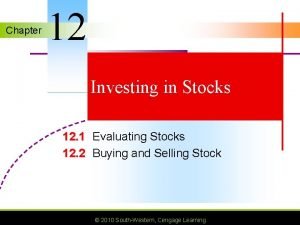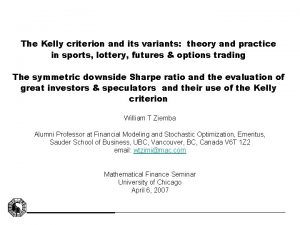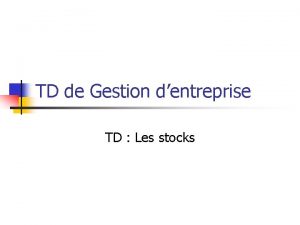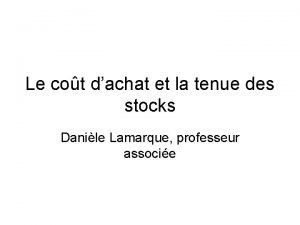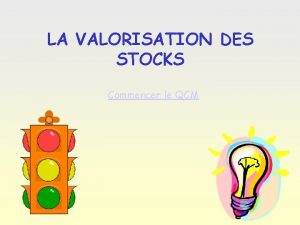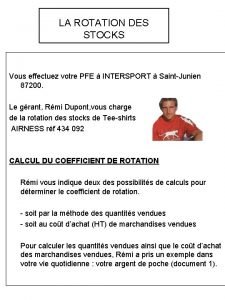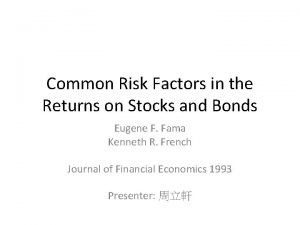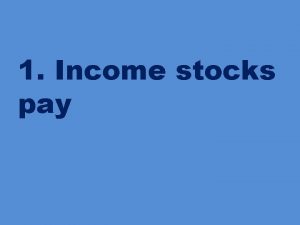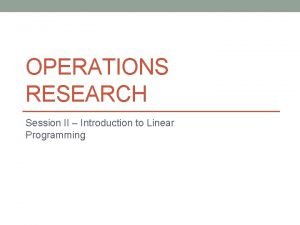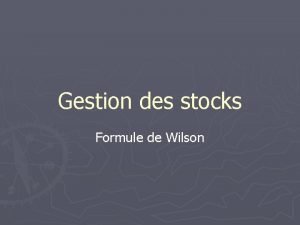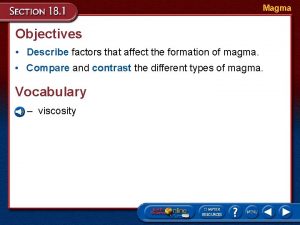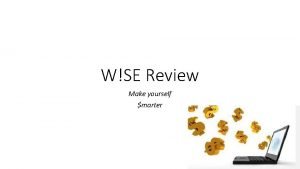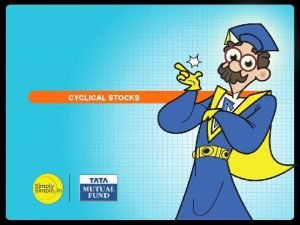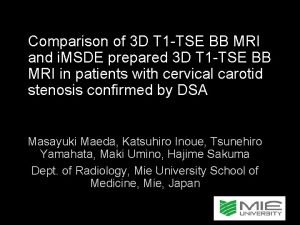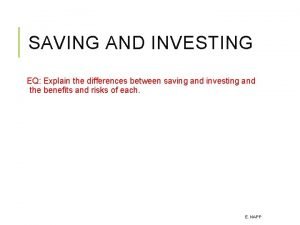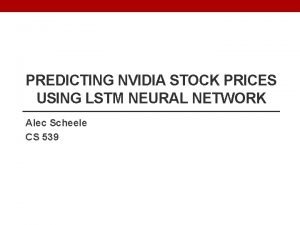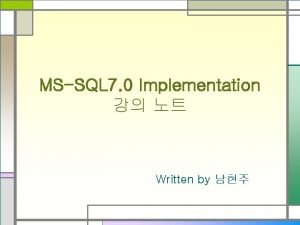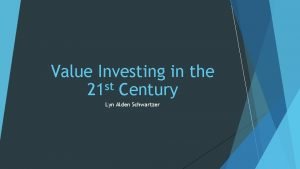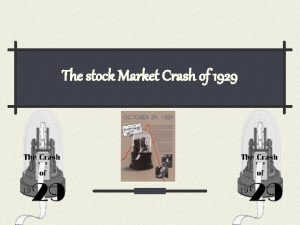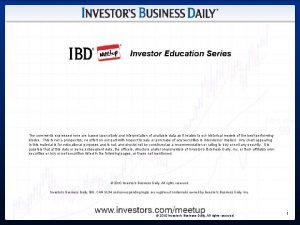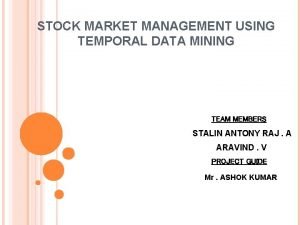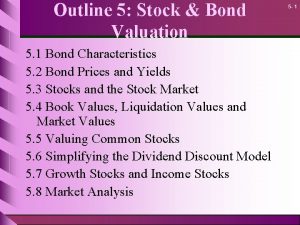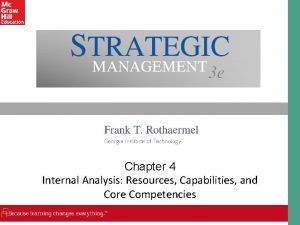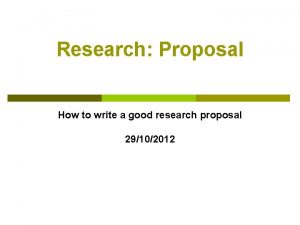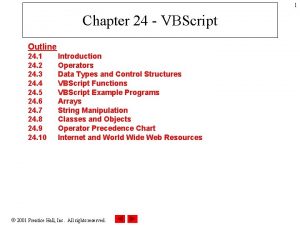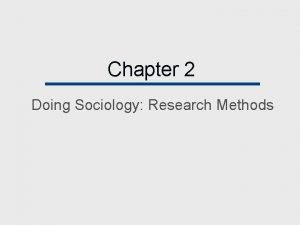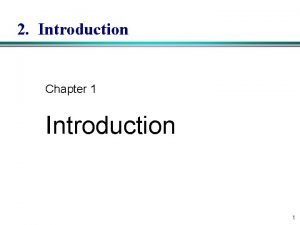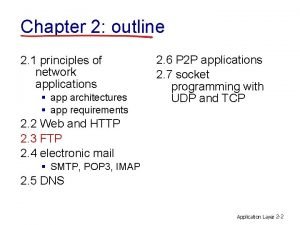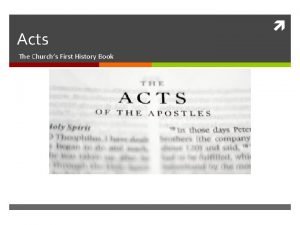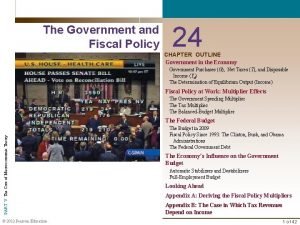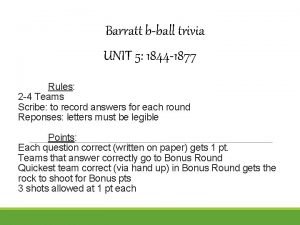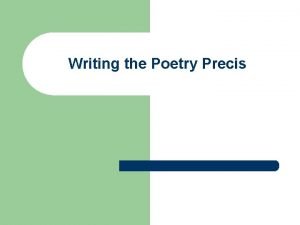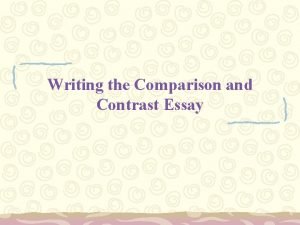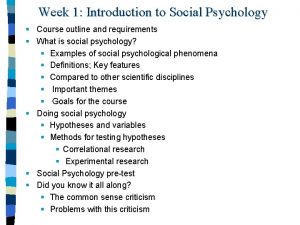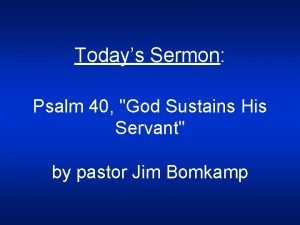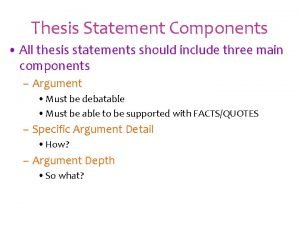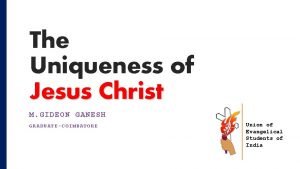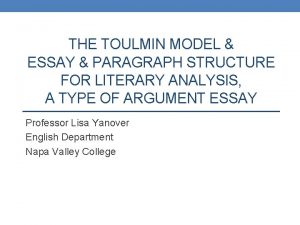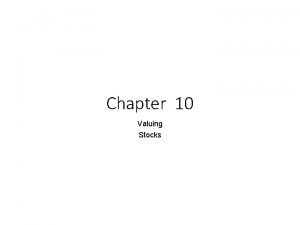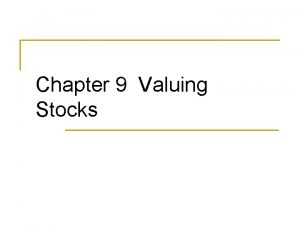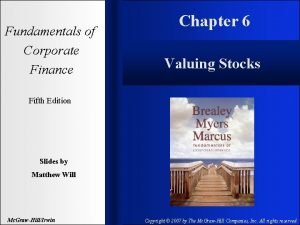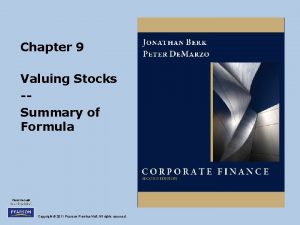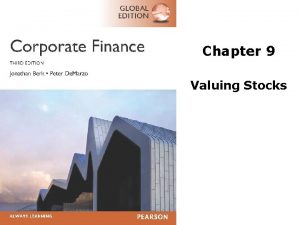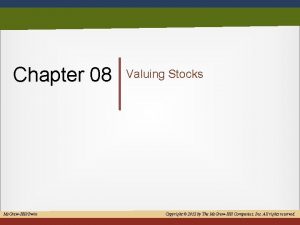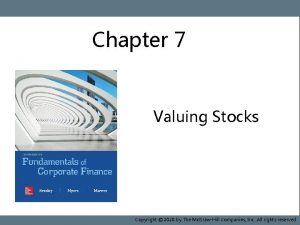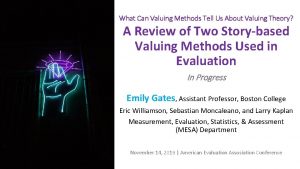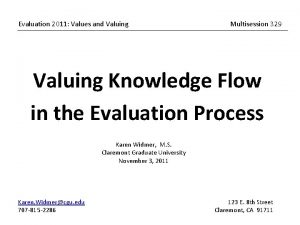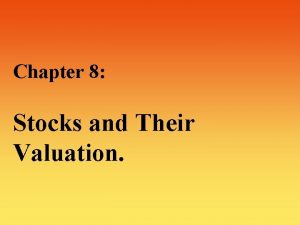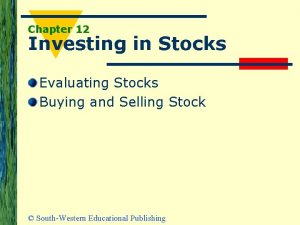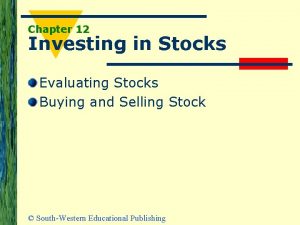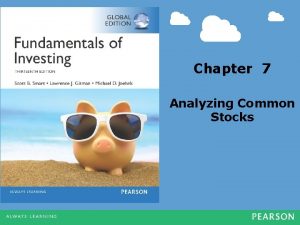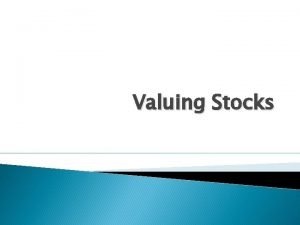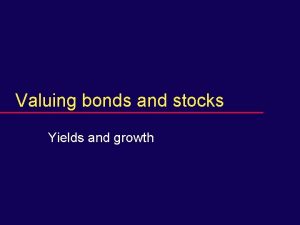Chapter 9 Valuing Stocks Chapter Outline 9 1









































































































- Slides: 105

Chapter 9 Valuing Stocks

Chapter Outline 9. 1 The Dividend-Discount Model 9. 2 Applying the Dividend-Discount Model 9. 3 Total Payout and Free Cash Flow Valuation Models 9. 4 Valuation Based on Comparable Firms 9. 5 Information, Competition, and Stock Prices

Learning Objectives 1. Describe, in words, the Law of One Price value for a common stock, including the discount rate that should be used. 2. Calculate the total return of a stock, given the dividend payment, the current price, and the previous price.

Learning Objectives 3. Use the dividend-discount model to compute the value of a dividend-paying company’s stock, whether the dividends grow at a constant rate starting now or at some time in the future. 4. Discuss the determinants of future dividends and growth rate in dividends, and the sensitivity of the stock price to estimates of those two factors.

Learning Objectives (cont'd) 5. Given the retention rate and the return on new investment, calculate the growth rate in dividends, earnings, and share price. 6. Describe circumstances in which cutting the firm’s dividend will raise the stock price.

Learning Objectives (cont'd) 7. Assuming a firm has a long-term constant growth rate after time N + 1, use the constant growth model to calculate the terminal value of the stock at time N. 8. Compute the stock value of a firm that pays dividends as well as repurchasing shares.

Learning Objectives (cont'd) 9. Use the discounted free cash flow model to calculate the value of stock in a company with leverage. 10. Use comparable firm multiples to estimate stock value. 11. Explain why several valuation models are required to value a stock. 12. Describe the impact of efficient markets hypothesis on positive-NPV trades by individuals with no inside information.

Learning Objectives (cont'd) 13. Discuss why investors who identify positive. NPV trades should be skeptical about their findings, unless they have inside information or a competitive advantage. As part of that, describe the return the average investor should expect to get. 14. Assess the impact of stock valuation on recommended managerial actions.

9. 1 The Dividend-Discount Model • A One-Year Investor – Potential Cash Flows • Dividend • Sale of Stock – Timeline for One-Year Investor • Since the cash flows are risky, we must discount them at the equity cost of capital.

9. 1 The Dividend-Discount Model (cont'd) • A One-Year Investor – If the current stock price were less than this amount, expect investors to rush in and buy it, driving up the stock’s price. – If the stock price exceeded this amount, selling it would cause the stock price to quickly fall.

Dividend Yields, Capital Gains, and Total Returns • Dividend Yield • Capital Gain – Capital Gain Rate • Total Return – Dividend Yield + Capital Gain Rate • The expected total return of the stock should equal the expected return of other investments available in the market with equivalent risk.

Textbook Example 9. 1

Textbook Example 9. 1 (cont'd)

Alternative Example 9. 1 • Problem – 3 M (MMM) just paid a dividend of $4. 50 per share. – You expect the stock price will $178. 50 and the dividend to be 5% higher by the end of the year. – Investments with equivalent risk have an expected return of 11%. – Based on the Dividend-Discount Model, what would pay today for 3 M stock?

Alternative Example 9. 1 (cont’d) • Solution – Dividend in one year • $4. 50 x 1. 05 = $4. 725

A Multi-Year Investor • What is the price if we plan on holding the stock for two years?

The Dividend-Discount Model Equation • What is the price if we plan on holding the stock for N years? – This is known as the Dividend-Discount Model. • Note that the above equation (9. 4) holds for any horizon N. Thus all investors (with the same beliefs) will attach the same value to the stock, independent of their investment horizons.

The Dividend-Discount Model Equation (cont'd) • The price of any stock is equal to the present value of the expected future dividends it will pay.

9. 2 Applying the Discount-Dividend Model • Constant Dividend Growth – The simplest forecast for the firm’s future dividends states that they will grow at a constant rate, g, forever.

9. 2 Applying the Discount-Dividend Model (cont'd) • Constant Dividend Growth Model – The value of the firm depends on the current dividend level, the cost of equity, and the growth rate.

Textbook Example 9. 2

Textbook Example 9. 2 (cont'd)

Alternative Example 9. 2 • Problem – AT&T plans to pay $1. 44 per share in dividends in the coming year. – Its equity cost of capital is 8%. – Dividends are expected to grow by 4% per year in the future. – Estimate the value of AT&T’s stock.

Alternative Example 9. 2 (cont’d)

Dividends Versus Investment and Growth • A Simple Model of Growth – Dividend Payout Ratio • The fraction of earnings paid as dividends each year

Dividends Versus Investment and Growth (cont'd) • A Simple Model of Growth – Assuming the number of shares outstanding is constant, the firm can do two things to increase its dividend: • Increase its earnings (net income) • Increase its dividend payout rate

Dividends Versus Investment and Growth (cont'd) • A Simple Model of Growth – A firm can do one of two things with its earnings: • It can pay them out to investors. • It can retain and reinvest them.

Dividends Versus Investment and Growth (cont'd) • A Simple Model of Growth – Retention Rate • Fraction of current earnings that the firm retains

Dividends Versus Investment and Growth (cont'd) • A Simple Model of Growth – If the firm keeps its retention rate constant, then the growth rate in dividends will equal the growth rate of earnings.

Dividends Versus Investment and Growth (cont'd) • Profitable Growth – If a firm wants to increase its share price, should it cut its dividend and invest more, or should it cut investment and increase its dividend? • The answer will depend on the profitability of the firm’s investments. – Cutting the firm’s dividend to increase investment will raise the stock price if, and only if, the new investments have a positive NPV.

Textbook Example 9. 3

Textbook Example 9. 3 (cont'd)

Textbook Example 9. 4

Textbook Example 9. 4 (cont'd)

Alternative Example 9. 4 • Problem – Dren Industries is considering expanding into a new product line. – Earnings per share expected to be $5 in the coming year and are expected to grow annually at 5% without the new product line but growth would increase to 7% if the new product line is introduced. – To finance the expansion, Dren would need to cut its dividend payout ratio from 80% to 50%. – If Dren’s equity cost of capital is 11%, what would be the impact on Dren’s stock price if they introduce the new product line? Assume the equity cost of capital will remain unchanged.

Alternative Example 9. 4 (cont’d) • Solution – First, calculate the current price for Dren if they do not introduce the new product. To calculate the price, D 1 is needed. To find D 1, EPS 1 is required: EPS 1 = EPS 0 × (1 + g) = $5. 00 × 1. 05 = $5. 25 D 1 = EPS 1 × Payout Ratio = $5. 25 × 0. 8 = $4. 20 P 0 = D 1/(r. E - g) = $4. 20/(0. 11 - 0. 05) = $70. 00 – Thus, the current price without the new product should be $70 per share.

Alternative Example 9. 4 (cont’d) • Solution – Next, calculate the expected current price for Dren if they introduce the new product: EPS 1 = EPS 0 × (1 + g) = $5. 00 × 1. 07 = $5. 35 D 1 = EPS 1 × Payout Ratio = $5. 35 × 0. 50 = $2. 675 P 0 = D 1/(r. E - g) = $2. 675/(0. 11 - 0. 07) = $66. 875 – Thus, the current price is expected to fall from $70 to $66. 875 if the new product line is introduced.

Changing Growth Rates • We cannot use the constant dividend growth model to value a stock if the growth rate is not constant. – For example, young firms often have very high initial earnings growth rates. During this period of high growth, these firms often retain 100% of their earnings to exploit profitable investment opportunities. As they mature, their growth slows. At some point, their earnings exceed their investment needs, and they begin to pay dividends.

Changing Growth Rates (cont'd) • Although we cannot use the constant dividend growth model directly when growth is not constant, we can use the general form of the model to value a firm by applying the constant growth model to calculate the future share price of the stock once the expected growth rate stabilizes.

Changing Growth Rates (cont'd) • Dividend-Discount Model with Constant Long-Term Growth

Textbook Example 9. 5

Textbook Example 9. 5 (cont'd)

Limitations of the Dividend-Discount Model • There is a tremendous amount of uncertainty associated with forecasting a firm’s dividend growth rate and future dividends. • Small changes in the assumed dividend growth rate can lead to large changes in the estimated stock price.

9. 3 Total Payout and Free Cash Flow Valuation Models • Share Repurchases and the Total Payout Model – Share Repurchase • When the firm uses excess cash to buy back its own stock – Implications for the Dividend-Discount Model • The more cash the firm uses to repurchase shares, the less it has available to pay dividends. • By repurchasing, the firm decreases the number of shares outstanding, which increases its earnings and dividends per share.

9. 3 Total Payout and Free Cash Flow Valuation Models (cont'd) • Share Repurchases and the Total Payout Model

9. 3 Total Payout and Free Cash Flow Valuation Models (cont'd) • Share Repurchases and the Total Payout Model – Total Payout Model • Values all of the firm’s equity, rather than a single share. You discount total dividends and share repurchases and use the growth rate of earnings (rather than earnings per share) when forecasting the growth of the firm’s total payouts.

Textbook Example 9. 6

Textbook Example 9. 6 (cont'd)

Alternative Example 9. 6 • Problem – Montalvan Inc. expects to have $125 million in earnings for the year and earnings are expected to grow at 6% annually. – The firm does not pay any dividends, but it intends to use 25% of its earnings for stock repurchases. – Motalvan’s cost of equity is 15%, and it has 25 million shares outstanding. – What is Montalvan’s stock price?

Alternative Example 9. 6 (cont’d) • Solution – Amount dedicated to stock repurchases • 25% x $125 million = $31. 25 million

The Discounted Free Cash Flow Model • Discounted Free Cash Flow Model – Determines the value of the firm to all investors, including both equity and debt holders – The enterprise value can be interpreted as the net cost of acquiring the firm’s equity, taking its cash, paying off all debt, and owning the unlevered business.

The Discounted Free Cash Flow Model (cont'd) • Valuing the Enterprise – Free Cash Flow • Cash flow available to pay both debt holders and equity holders – Discounted Free Cash Flow Model

The Discounted Free Cash Flow Model (cont'd) • Implementing the Model – Since we are discounting cash flows to both equity holders and debt holders, the free cash flows should be discounted at the firm’s weighted average cost of capital, rwacc. If the firm has no debt, rwacc = r. E.

The Discounted Free Cash Flow Model (cont'd) • Implementing the Model – Often, the terminal value is estimated by assuming a constant long-run growth rate g. FCF for free cash flows beyond year N, so that

Textbook Example 9. 7

Textbook Example 9. 7 (cont'd)

Alternative Example 9. 7 • Problem – At the end of 2016, Newerks Inc. forecasts that its free cash flow will be $50 million in 2017, $60 million in 2018, and $72 million in 2019. – After 2019, Newerks expects its free cash flow earnings to grow at an annual rate of 6%. – Newerks has $75 million in debt and $25 million in cash. – If Newerks has 5 million shares outstanding and a cost of capital of 14%, what is Newerks stock price at the end of 2016?

Alternative Example 9. 7 (cont’d) • Solution – The terminal enterprise value at the end of 2019 is calculated as

Alternative Example 9. 7 (cont’d) • Solution – The present value of its free cash flows plus the terminal enterprise value is calculated as

The Discounted Free Cash Flow Model (cont'd) • Connection to Capital Budgeting – The firm’s free cash flow is equal to the sum of the free cash flows from the firm’s current and future investments, so we can interpret the firm’s enterprise value as the total NPV that the firm will earn from continuing its existing projects and initiating new ones. • The NPV of any individual project represents its contribution to the firm’s enterprise value. To maximize the firm’s share price, we should accept projects that have a positive NPV.

Textbook Example 9. 8

Textbook Example 9. 8 (cont'd)

Figure 9. 1 A Comparison of Discounted Cash Flow Models of Stock Valuation

9. 4 Valuation Based on Comparable Firms • Method of Comparables (Comps) – Estimate the value of the firm based on the value of other, comparable firms or investments that we expect will generate very similar cash flows in the future.

Valuation Multiples • Valuation Multiple – A ratio of firm’s value to some measure of the firm’s scale or cash flow • The Price-Earnings Ratio – P/E Ratio • Share price divided by earnings per share

Valuation Multiples (cont'd) • Trailing Earnings – Earnings over the last 12 months • Trailing P/E • Forward Earnings – Expected earnings over the next 12 months • Forward P/E

Valuation Multiples (cont'd) • Firms with high growth rates, and which generate cash well in excess of their investment needs so that they can maintain high payout rates, should have high P/E multiples.

Textbook Example 9. 9

Textbook Example 9. 9 (cont'd)

Alternative Example 9. 9 • Problem – Best Buy Co. Inc. (BBY) has earnings per share of $2. 22. – The average P/E of comparable companies’ stocks is 19. 7. – Estimate a value for Best Buy using the P/E as a valuation multiple.

Alternative Example 9. 9 (cont’d) • Solution – The share price for Best Buy is estimated by multiplying its earnings per share by the P/E of comparable firms. – P 0 = $2. 22 × 19. 7 = $43. 73

Valuation Multiples (cont'd) • Enterprise Value Multiples – This valuation multiple is higher for firms with high growth rates and low capital requirements (so that free cash flow is high in proportion to EBITDA).

Textbook Example 9. 10

Textbook Example 9. 10 (cont'd)

Alternative Example 9. 10 • Problem – Best Buy Co. Inc. (BBY) has EBITDA of $2, 766, 000 and 410 million shares outstanding. – Best Buy also has $1, 963, 000 in debt and $509, 000 in cash. – If Best Buy has an enterprise value to EBITDA multiple of 7. 7, estimate the value for a share of Best Buy stock.

Alternative Example 9. 10 (cont’d) • Solution – Using the enterprise value to EBITDA multiple, Best Buy’s enterprise value is $2, 766 million × 7. 7 = $21, 298. 20 million. – Subtract out the debt, add the cash, and divide by the number of shares to estimate the Best Buy’s share price.

Valuation Multiples (cont'd) • Other Multiples – Multiple of sales – Price to book value of equity per share – Enterprise value per subscriber • Used in cable TV industry

Limitations of Multiples • When valuing a firm using multiples, there is no clear guidance about how to adjust for differences in expected future growth rates, risk, or differences in accounting policies. • Comparables only provide information regarding the value of a firm relative to other firms in the comparison set. – Using multiples will not help us determine if an entire industry is overvalued,

Comparison with Discounted Cash Flow Methods • Discounted cash flows methods have the advantage that they can incorporate specific information about the firm’s cost of capital or future growth. – The discounted cash flow methods have the potential to be more accurate than the use of a valuation multiple.

Table 9. 1 Stock Prices and Multiples for the Footwear Industry, January 2006

Stock Valuation Techniques: The Final Word • No single technique provides a final answer regarding a stock’s true value. All approaches require assumptions or forecasts that are too uncertain to provide a definitive assessment of the firm’s value. – Most real-world practitioners use a combination of these approaches and gain confidence if the results are consistent across a variety of methods.

Figure 9. 2 Range of Valuations for KCP Stock Using Alternative Valuation Methods

9. 5 Information, Competition, and Stock Prices • Information in Stock Prices – Our valuation model links the firm’s future cash flows, its cost of capital, and its share price. Given accurate information about any two of these variables, a valuation model allows us to make inferences about the third variable.

Figure 9. 3 The Valuation Triad

9. 5 Information, Competition, and Stock Prices (cont'd) • Information in Stock Prices – For a publicly traded firm, its current stock price should already provide very accurate information, aggregated from a multitude of investors, regarding the true value of its shares. • Based on its current stock price, a valuation model will tell us something about the firm’s future cash flows or cost of capital.

Textbook Example 9. 11

Textbook Example 9. 11 (cont'd)

Alternative Example 9. 11 • Problem – Fit. One Company plans to pay a dividend this year of $3. 50 per share. – Its equity cost of capital is 12%, and you expect its dividends to grow at a rate of about 3% per year, though you are somewhat unsure of the precise growth rate. – If Fit. One’s stock is currently trading for $45. 00 per share, how would you update your beliefs about its dividend growth rate?

Alternative Example 9. 11 (cont’d) • Solution – Applying the constant dividend growth model based on a 3% growth rate, we would estimate a stock price of P 0 = $3. 50/(0. 12 - 0. 03) = $38. 89 per share. – The market price of $45. 00, however, implies that most investors expect dividends to grow at a somewhat faster rate.

Alternative Example 9. 11 (cont’d) • Solution – If we continue to assume a constant growth rate, we can solve for the growth rate consistent with the current market price using Eq. 9. 7:

Competition and Efficient Markets • Efficient Markets Hypothesis – Implies that securities will be fairly priced, based on their future cash flows, given all information that is available to investors.

Competition and Efficient Markets (cont'd) • Public, Easily Interpretable Information – If the impact of information that is available to all investors (news reports, financials statements, etc. ) on the firm’s future cash flows can be readily ascertained, then all investors can determine the effect of this information on the firm’s value. • In this situation, we expect the stock price to react nearly instantaneously to such news.

Textbook Example 9. 12

Textbook Example 9. 12 (cont'd)

Competition and Efficient Markets (cont'd) • Private or Difficult-to-Interpret Information – Private information will be held by a relatively small number of investors. These investors may be able to profit by trading on their information. • In this case, the efficient markets hypothesis will not hold in the strict sense. However, as these informed traders begin to trade, they will tend to move prices, so over time prices will begin to reflect their information as well.

Competition and Efficient Markets (cont'd) • Private or Difficult-to-Interpret Information – If the profit opportunities from having private information are large, others will devote the resources needed to acquire it. • In the long run, we should expect that the degree of “inefficiency” in the market will be limited by the costs of obtaining the private information.

Textbook Example 9. 13

Textbook Example 9. 13 (cont'd)

Figure 9. 4 Possible Stock Price Paths for Example 9. 13

Lessons for Investors and Corporate Managers • Consequences for Investors – If stocks are fairly priced, then investors who buy stocks can expect to receive future cash flows that fairly compensate them for the risk of their investment. • In such cases, the average investor can invest with confidence, even if he is not fully informed.

Lessons for Investors and Corporate Managers (cont'd) • Implications for Corporate Managers – Focus on NPV and free cash flow – Avoid accounting illusions – Use financial transactions to support investment

The Efficient Markets Hypothesis Versus No Arbitrage • The efficient markets hypothesis states that securities with equivalent risk should have the same expected return. • An arbitrage opportunity is a situation in which two securities with identical cash flows have different prices.

Discussion of Data Case Key Topic • How do the assumptions regarding the cost of equity, cost of debt, and expected return on investments impact your decision? • How sensitive are your estimates for GE’s stock price and enterprise value to these assumptions?

Chapter Quiz 1. What discount rate do you use to discount the future cash flows of a stock? 2. Does an investor’s expected holding period affect the amount they would be willing to pay for a stock? 3. How can a firm increase its future dividend per share? 4. What is the enterprise value of a firm? 5. What are the implicit assumptions made when valuing a firm using multiples?

Chapter Quiz 6. What is the efficient market hypothesis? What are its implications for corporate managers?
 Valuation of private companies
Valuation of private companies Example of cognitive objectives in lesson plan
Example of cognitive objectives in lesson plan Psychomotor objectives examples
Psychomotor objectives examples Domain behavior
Domain behavior Triumvirate rome
Triumvirate rome Resoect quotes
Resoect quotes Valuing innovation
Valuing innovation Intellectual property valuing
Intellectual property valuing Factual inquiry in ethics
Factual inquiry in ethics Valuing callable bonds
Valuing callable bonds Bonds with embedded options
Bonds with embedded options Valuing distressed companies
Valuing distressed companies Valuing culture
Valuing culture Valuing land for social housing
Valuing land for social housing Valuing cyclical companies
Valuing cyclical companies Valuing distressed and declining companies
Valuing distressed and declining companies A flavorful liquid made by gently simmering bones
A flavorful liquid made by gently simmering bones Chapter 11 stocks
Chapter 11 stocks Chapter 17 investing in stocks
Chapter 17 investing in stocks Chapter 6 stocks sauces and soups
Chapter 6 stocks sauces and soups Chapter 6 stocks sauces and soups
Chapter 6 stocks sauces and soups Bechamel sauce
Bechamel sauce 17 invest
17 invest Siteserve
Siteserve Chapter 12 investing in stocks
Chapter 12 investing in stocks Chapter 12 investing in stocks
Chapter 12 investing in stocks Chapter 11 stocks
Chapter 11 stocks Sandwich statements
Sandwich statements Difference between stocks and bonds
Difference between stocks and bonds Kelly formula calculator stocks
Kelly formula calculator stocks Td gestion des stocks
Td gestion des stocks Describe the four important parts of stock
Describe the four important parts of stock Nourishing element
Nourishing element Mother sauce name
Mother sauce name Tenue de stock
Tenue de stock Qcm gestion des stocks
Qcm gestion des stocks Coefficient rotation des stocks
Coefficient rotation des stocks Common risk factors in the returns on stocks and bonds
Common risk factors in the returns on stocks and bonds Income stocks pay
Income stocks pay Why stocks are considered the foundation of cooking
Why stocks are considered the foundation of cooking A retail store stocks two types of shirts a and b
A retail store stocks two types of shirts a and b Formule wilson
Formule wilson Base counting stocks
Base counting stocks Brown beef stock appearance and presentation
Brown beef stock appearance and presentation How do batholiths, stocks, and laccoliths differ?
How do batholiths, stocks, and laccoliths differ? Cartographie des risques gestion des stocks
Cartographie des risques gestion des stocks Before the kiss corporation can issue stocks
Before the kiss corporation can issue stocks Phantom equity
Phantom equity Gestion des stocks
Gestion des stocks Introduction sur la gestion des stocks
Introduction sur la gestion des stocks How to identify cyclical stocks
How to identify cyclical stocks Blackberry share price
Blackberry share price Common stock characteristics
Common stock characteristics Source of starch
Source of starch Similarities between saving and investing
Similarities between saving and investing Nvida stocks
Nvida stocks Mssql nvl
Mssql nvl Lyn alden russia
Lyn alden russia Tf meaning stocks
Tf meaning stocks 1920
1920 Ibd market pulse historical data
Ibd market pulse historical data Stocks and sauces
Stocks and sauces Data mining stocks
Data mining stocks Puritan stocks punishment
Puritan stocks punishment Pvgo example
Pvgo example Comment calculer un cadencier
Comment calculer un cadencier How are intangible resource stocks acquired?
How are intangible resource stocks acquired? Labeling theory examples
Labeling theory examples Romans outline by chapter
Romans outline by chapter Components of introduction in research proposal
Components of introduction in research proposal Foner chapter 27
Foner chapter 27 Secondary data
Secondary data Chapter 38 a world without borders outline
Chapter 38 a world without borders outline 24 chapter outline
24 chapter outline Hunger games chapter 10 questions and answers
Hunger games chapter 10 questions and answers Chapter 31 societies at crossroads outline
Chapter 31 societies at crossroads outline Ap world history chapter 28 outline
Ap world history chapter 28 outline Observation research method
Observation research method Chapter 1 outline
Chapter 1 outline Chapter 1 outline
Chapter 1 outline Agent orange and napalm
Agent orange and napalm Chapter 2 outline
Chapter 2 outline Outline book of acts
Outline book of acts 24 chapter outline
24 chapter outline 24 chapter outline
24 chapter outline Forty niners apush
Forty niners apush Precis paragraph format
Precis paragraph format Leq essay format
Leq essay format Block organization essay
Block organization essay Sociocultural psychology examples
Sociocultural psychology examples Lesson outline lesson 3 describing circuits answers
Lesson outline lesson 3 describing circuits answers What are protists lesson outline
What are protists lesson outline Outline of the book of numbers
Outline of the book of numbers Types of interior displays
Types of interior displays Mountain building
Mountain building Lesson outline lesson 2 aquatic ecosystems answer key
Lesson outline lesson 2 aquatic ecosystems answer key Enduring issues essay graphic organizer
Enduring issues essay graphic organizer Us bank api
Us bank api Army training outline
Army training outline Psalm 61 sermon outline
Psalm 61 sermon outline Psalm 46 sermon outline
Psalm 46 sermon outline Psalm 40 sermon outline
Psalm 40 sermon outline Pathology outline
Pathology outline Parts of a thesis
Parts of a thesis The uniqueness of jesus christ
The uniqueness of jesus christ Toulmin paragraph example
Toulmin paragraph example
